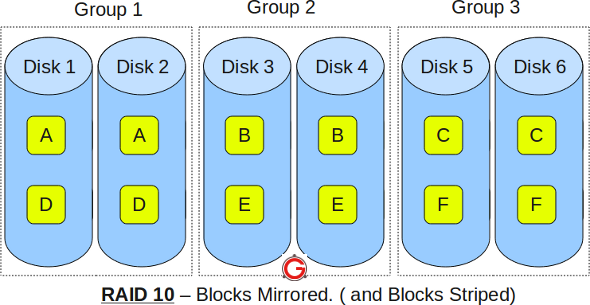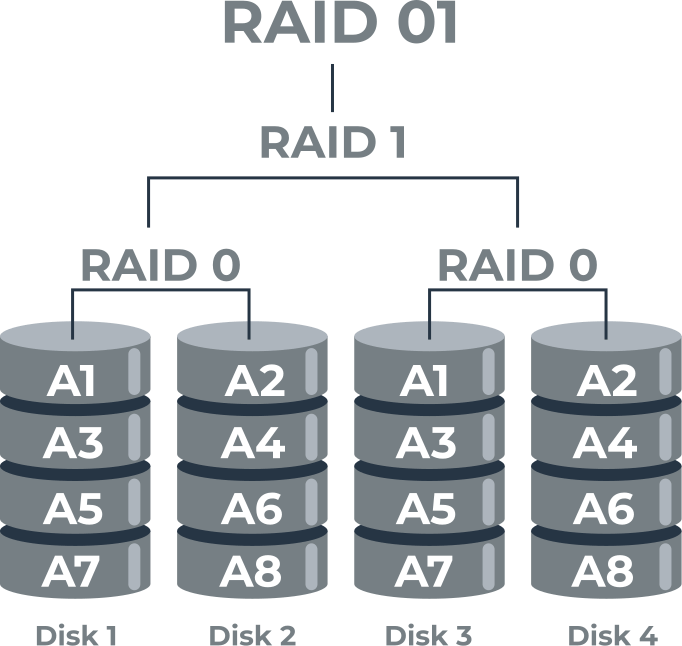RAID 1 vs RAID 10: Detailed Comparison of Performance, Cost, and Use Cases
Performance:
- RAID 1 mirrors data across two disks, providing redundancy but limited performance improvement. Read speeds can improve since data can be read from either disk, but write speeds remain similar to a single disk because data must be written to both disks.
- RAID 10 (also called RAID 1+0) combines mirroring and striping. It requires a minimum of four disks, where data is mirrored in pairs and then striped across those pairs. This setup offers significantly better performance:
- Read speeds can be up to 4x faster with 4 disks.
- Write speeds can be up to 2x faster than RAID 1.
- Overall, RAID 10 can deliver 10-50% better performance than RAID 1, especially noticeable with large datasets or database workloads.
Cost:
- RAID 1 requires only two disks, so the initial hardware cost is lower.
- RAID 10 requires at least four disks, doubling the minimum hardware cost compared to RAID 1.
- Both RAID 1 and RAID 10 have a 50% storage efficiency because half of the total disk capacity is used for mirroring.
- RAID 10 may also incur higher costs if hardware RAID controllers are used to maximize performance, whereas RAID 1 can be implemented more simply, including via software RAID.
Fault Tolerance and Reliability:
- RAID 1 can tolerate the failure of one disk without data loss.
- RAID 10 offers higher fault tolerance because it can sustain multiple disk failures as long as no mirrored pair loses all its disks. This makes RAID 10 more reliable and secure than RAID 1.
- RAID 10 is simpler to set up and rebuild after disk failure compared to RAID 01 (a different RAID 0+1 configuration), and it provides better data protection.
Use Cases:
- RAID 1 is suitable for small-scale systems or environments where cost is a concern and moderate redundancy is sufficient, such as small servers or desktop systems.
- RAID 10 is ideal for high-performance, mission-critical applications requiring both speed and redundancy, such as database servers, web servers with heavy I/O, and enterprise environments where uptime and data integrity are paramount.
| Aspect | RAID 1 | RAID 10 |
|---|---|---|
| Minimum Disks | 2 | 4 |
| Storage Efficiency | 50% (mirroring) | 50% (mirroring + striping) |
| Read Performance | Improved (reads from either disk) | Up to 4x faster (striped mirrors) |
| Write Performance | Similar to single disk | Up to 2x faster than RAID 1 |
| Fault Tolerance | Can tolerate 1 disk failure | Can tolerate multiple failures if not in the same mirrored pair |
| Cost | Lower (fewer disks) | Higher (more disks, possible hardware RAID) |
| Use Cases | Small servers, desktops | High-performance servers, databases, critical systems |
In summary, RAID 10 offers superior performance and reliability at a higher cost and complexity, while RAID 1 is simpler and cheaper but with limited performance gains. The choice depends on workload demands, budget, and required fault tolerance.




















WebSeoSG offers the highest quality website traffic services in Singapore. We provide a variety of traffic services for our clients, including website traffic, desktop traffic, mobile traffic, Google traffic, search traffic, eCommerce traffic, YouTube traffic, and TikTok traffic. Our website boasts a 100% customer satisfaction rate, so you can confidently purchase large amounts of SEO traffic online. For just 40 SGD per month, you can immediately increase website traffic, improve SEO performance, and boost sales!
Having trouble choosing a traffic package? Contact us, and our staff will assist you.
Free consultation